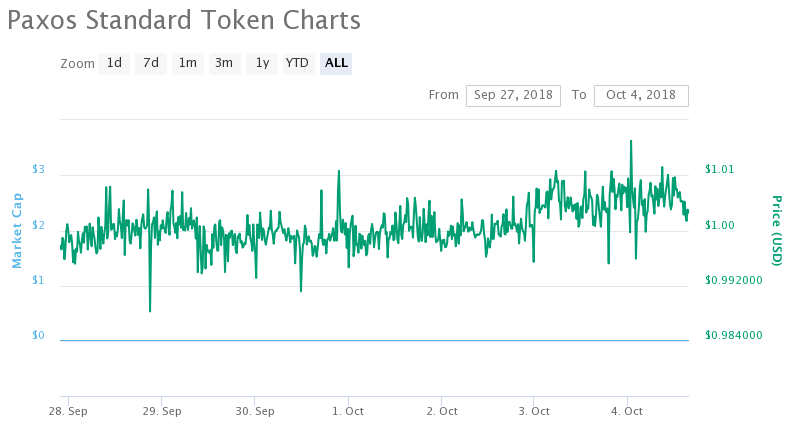Regulated Stablecoins
When I first started following the stablecoin universe, there were only three stablecoins choose from: Nubits, Tether, and BitUSD. But these were always wild, unregulated experiments. Things are changing. With a whole raft of new entrants, stablecoins seem to be going mainstream. And now regulated stablecoins have arrived.
Earlier this month, two new stablecoins were announced. The Gemini dollar will be issued by Gemini Trust, which also runs the Gemini cryptocurrency exchange. Meanwhile the Paxos Trust, which owns the itBit exchange, is issuing the Paxos Standard stablecoin. Both stablecoins will be backed one-for-one by U.S. dollars held in a bank account.
Like Bitcoin, these two stablecoins will be blockchain-based. Specifically, both the Paxos Standard and Gemini dollar will be built on the Ethereum blockchain. Unlike Bitcoin, however, each stablecoin has a connection to underlying U.S. dollars, which means its purchasing power will be stabilized, very much like a regular bank-account dollar. This is a useful property since most people prefer their money to not be volatile.
What makes the Gemini dollar and the Paxos Standard unique is that they are described as being “regulated.” Specifically, both are licensed by the New York State Department of Financial Services, or NYDFS. The NYDFS is one of many state bodies that regulate money transmitters, including PayPal and Square.
Regulation means both Gemini and Paxos must comply with NYDFS anti-money-laundering (AML) rules as well as efforts to counter the financing of terrorists (CFT). Here is the puzzle. If Jim asks Gemini Trust to convert the U.S. dollars in his bank account into Gemini dollars, Gemini can easily conduct AML and CFT checks on Jim before executing the conversion for him. Likewise, if Jane asks Gemini to redeem her Gemini dollars with U.S. dollar deposits, it can run a check on her too. But how does Gemini run AML and CFT checks on Joe, who got his coins from Jim and paid them to Jane? It is easy to enforce the checks at the on and off ramps, but there is a potentially infinite person-to-person transactional chain that must also be monitored.
In the case of Paxos, a quick look at its white paper shows that Chainalysis, a company that specializes in parsing blockchains for information, will be conducting “ongoing transaction monitoring and risk assessments for fraud detection and prevention.” The Ethereum blockchain is not anonymous, so Chainalysis should have an easy time of it. If a coin’s provenance is deemed suspicious by Chainalysis, it will presumably be flagged and Paxos will refuse to redeem it. So the offending coin will become valueless, or at least trade at a massive discount. Perhaps this form of monitoring is enough to comply with NYDFS money-laundering and terrorist-financing rules.
Gemini is more circumspect about its anti-money-laundering policies. In its white paper, it notes that its design allows it to “pause, block, or reverse token transfers in response to a security incident (i.e., catastrophic event) or if legally obligated or compelled to do so by a court of law or other governmental body.”
Alex Lebed took a deep dive into the code undergirding the Gemini dollar and found that Gemini has programmed in the ability to freeze any account. This measure has no doubt been taken to comply with the NYDFS’s requirement that law enforcement agencies be empowered to render any stablecoin unrecoverable, render it unusable, or even destroy it. But it remains to be seen how exactly Gemini will determine who is using Gemini dollars for legal purposes and who is breaking the rules.
There is an underlying inconsistency with these regulated stablecoins. A guiding reason for building a payments scheme on a blockchain is to create an open, censorship-resistant system. Rather than being operated by a single centralized owner, blockchains are run by a decentralized network of anonymous nodes. These nodes have no motivation to exclude any particular transaction. If they did, they’d forfeit a commission. Nor can a government eager to censor easily exert pressure on nodes to comply: they are anonymous and dispersed. Because it is always located at a single, publicly known address, a centralized system is far easier for a censor to usurp.
Censorship resistance comes at a cost, however. The decentralized web of validators that maintain a blockchain can only arrive at a consensus about a transaction’s validity by using an energy-intensive process called proof of work. A centralized hub needn’t bother with this arduous process. So it will always be cheaper and faster to run a payments system centrally, as a bank does, rather than in a decentralized manner.
Can you see the inconsistency by now? The Gemini dollar and Paxos Standard are issued on Ethereum, a relatively expensive and slow platform. The expense has an associated benefit, the ability to foster an open and censorship-resistant payments platform. By programming their stablecoins to comply with NYDFS regulations, Gemini and Paxos are removing all of the benefits of building on Ethereum. Yet they are still stuck with all of Ethereum’s drawbacks.
If these stablecoins are going to censor transactions, why not just avoid blockchains altogether and create a centralized and speedy alternative — something like, I don’t know, Paypal? Maybe someone can explain to me in the comments how all of this makes sense.












